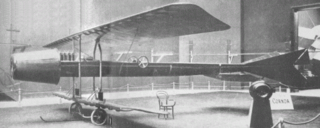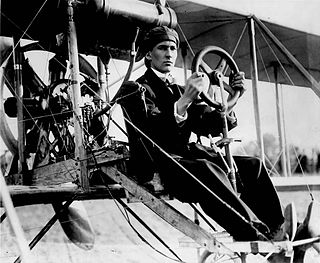
The Coandă-1910, designed by Romanian inventor Henri Coandă, was an unconventional sesquiplane aircraft powered by a ducted fan. Called the "turbo-propulseur" by Coandă, its experimental engine consisted of a conventional piston engine driving a multi-bladed centrifugal blower which exhausted into a duct. The unusual aircraft attracted attention at the Second International Aeronautical Exhibition in Paris in October 1910, being the only exhibit without a propeller, but the aircraft was not displayed afterwards and it fell from public awareness. Coandă used a similar turbo-propulseur to drive a snow sledge, but he did not develop it further for aircraft.

Glenn Hammond Curtiss was an American aviation and motorcycling pioneer, and a founder of the U.S. aircraft industry. He began his career as a bicycle racer and builder before moving on to motorcycles. As early as 1904, he began to manufacture engines for airships. In 1908, Curtiss joined the Aerial Experiment Association, a pioneering research group, founded by Alexander Graham Bell at Beinn Bhreagh, Nova Scotia, to build flying machines.

Chennai International Airport is an international airport serving the city of Chennai, Tamil Nadu and its metropolitan area. It is located in Tirusulam, 21 km (13 mi) southwest of the city centre. Chennai International Airport is the sixth busiest airport in India and third busiest airport for international traffic in India. It was also 49th busiest airport in Asia in 2018 making it one of the four major airports in India under the top 50 list of 2018. In financial year 2021, the airport handled 9.53 million passengers.

John William Dunne was a British soldier, aeronautical engineer and philosopher. As a young man he fought in the Second Boer War, before becoming a pioneering aeroplane designer in the early years of the 20th century. Dunne worked on automatically stable aircraft, many of which were of tailless swept wing design, to achieve the first certified stable aircraft. He later developed a new approach to dry fly fishing before turning to speculative philosophy, where he achieved some prominence and literary influence through his "serialism" theory on the nature of time and consciousness, explained in his book An Experiment with Time.

The Aerial Experiment Association (AEA) was a Canadian-American aeronautical research group formed on 30 September 1907, under the leadership of Dr. Alexander Graham Bell.
This is a list of aviation-related events from 1910:

Antoinette was a French manufacturer of light petrol engines. Antoinette also became a pioneer-era builder of aeroplanes before World War I, most notably the record-breaking monoplanes flown by Hubert Latham and René Labouchère. Based in Puteaux, the Antoinette concern was in operation between 1903 and 1912. The company operated a flying school at Chalons for which it built one of the earliest flight simulators.

SPAD was a French aircraft manufacturer active between 1911 and 1921. Its SPAD S.XIII biplane was the most produced French fighter airplane of the First World War.

Early flying machines include all forms of aircraft studied or constructed before the development of the modern aeroplane by 1910. The story of modern flight begins more than a century before the first successful manned aeroplane, and the earliest aircraft thousands of years before.

Gabriel Voisin was a French aviation pioneer and the creator of Europe's first manned, engine-powered, heavier-than-air aircraft capable of a sustained (1 km), circular, controlled flight, which was made by Henry Farman on 13 January 1908 near Paris, France. During World War I the company founded by Voisin became a major producer of military aircraft, notably the Voisin III. Subsequently, he switched to the design and production of luxury automobiles under the name Avions Voisin.

The Boxkite was the first aircraft produced by the British and Colonial Aeroplane Company. A pusher biplane based on the successful Farman III, it was one of the first aircraft types to be built in quantity. As the type was used by Bristol for instruction purposes at their flying schools at Larkhill and Brooklands many early British aviators learned to fly in a Boxkite. Four were purchased in 1911 by the War Office and examples were sold to Russia and Australia. It continued to be used for training purposes until after the outbreak of the First World War.

Louis Ferdinand Ferber was a French Army officer who played an important role in the development of aviation during the early 1900s. Although his aircraft experiments were belatedly successful, his early recognition and publicizing of the work of the Wright Brothers was a major influence on the development of aviation in Europe.
Preston Albert Watson was a Scottish aviation pioneer, who conceived his own original method of controlling an aeroplane in flight. This was his rocking wing method of lateral control, which consisted of a secondary smaller wing mounted above the main wing on an A-frame that could pivot about its longitudinal axis. Watson's method of lateral control was applied by him in three different aeroplanes; the first was built in late 1909, the second in July 1910 and his third in 1913.

Aéroplanes Voisin was a French aircraft manufacturing company established in 1905 by Gabriel Voisin and his brother Charles, and was continued by Gabriel after Charles died in an automobile accident in 1912; the full official company name then became Société Anonyme des Aéroplanes G. Voisin. During World War I, it was a major producer of military aircraft, notably the Voisin III. After the war Gabriel Voisin abandoned the aviation industry, and set up a company to design and produce luxury automobiles, called Avions Voisin.

The British Army Aeroplane No 1 or sometimes Cody 1 was a biplane built by Samuel Franklin Cody in 1907 at the Army Balloon Factory at Farnborough. It made the first recognised powered and sustained flight in the United Kingdom on 16 October 1908.

The 1907 Voisin biplane, was the first successful powered aircraft designed by aeronautical engineer and manufacturer Gabriel Voisin. It was used by the French aviator Henri Farman to make the first heavier-than-air flight lasting more than a minute in Europe, and also to make the first full circle. The first examples of the aircraft were known by the name of their owners, for instance the Delagrange I, or the Henri Farman n°1. Farman made many modifications to his aircraft, and these were incorporated into later production aircraft built by Voisin. The type enjoyed widespread success, and around sixty were built.

Hotel d'Angelis was a luxury hotel and restaurant established in 1906 by Giacomo D'Angelis at Mount Road, Madras, India. The hotel is considered to have spearheaded the introduction of modern technology in India.

The Caudron Type A was the first successful aircraft built by René Caudron and his brother Gaston. During 1910 the Caudron brothers were briefly associated with the Société Anonyme Français d'Aviation (S.A.F.A.), and an example of the type was exhibited at the 1910 Paris Aero Salon as the S.A.F.A. Biplane.

The pioneer era of aviation was the period of aviation history between the first successful powered flight, generally accepted to have been made by the Wright Brothers on 17 December 1903, and the outbreak of the First World War in August 1914.

















